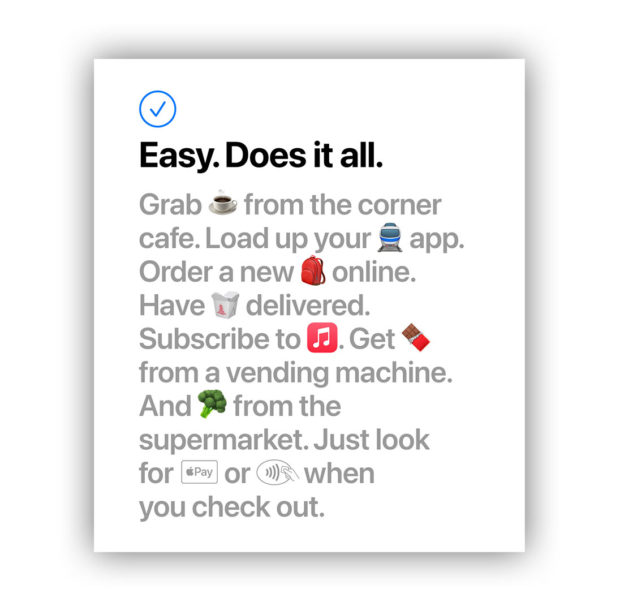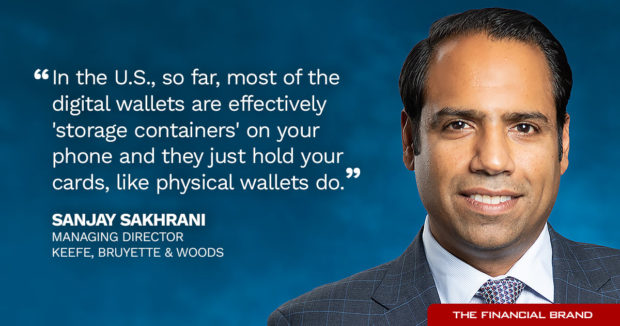Any talk of a U.S. superapp tends to prompt comparisons to China.
But payments analyst Sanjay Sakhrani — unlike many in the financial services industry — doesn’t consider the evolution of WeChat and Alipay a guide for what is likely to happen in the United States.
Periodic prognostication tends to focus on a company as “the one” that’s going to usher in America’s Age of Superapps. Revived talk about Elon Musk using “X,” the social media network formerly known as Twitter, as a springboard for establishing what he calls “an everything app” is just the latest case.
Sakhrani, a managing director at Keefe, Bruyette & Woods, is likewise skeptical about this scenario.
When it comes to payments innovation, what Americans really need and what they really want will be the driving force, he says.
All that being said, Sakhrani suggests that the U.S. superapp is already here, literally in the hands of about half of the country: the Apple iPhone.
Speaking in an interview with The Financial Brand, the analyst details how he arrived at this perspective.

The unfair advantage for financial brands.
Offering aggressive financial marketing strategies custom-built for leaders looking to redefine industry norms and establish market dominance.

The Financial Brand Forum Kicks Off May 20th
Explore the big ideas, new innovations and latest trends reshaping banking at The Financial Brand Forum. Will you be there? Don't get left behind.
Read More about The Financial Brand Forum Kicks Off May 20th
Why America’s Superapp Is Not Going to Be Like China’s
The topics of superapps and digital wallets are intertwined.
And it’s important to understand that digital wallets are not all the same — even though they are often discussed as if the meaning of the term is universal, Sakhrani says.
In China the advent of WeChat and Alipay — whose services include mobile payments — led to tectonic change. “Those digital wallets went out and disrupted China’s existing networks,” says Sakhrani.
Both services have payments functionality beyond that of China UnionPay, a government-run service that provides the major payment card program for mainland China.
In contrast, the U.S. versions of a digital wallet are simpler.
“In the U.S., so far, most of the digital wallets are effectively ‘storage containers’ on your phone,” says Sakhrani, “and they just hold your cards, like physical wallets do, and you can use them through the wallet.”
The operator of the wallet takes a cut of transactions, but, to the card issuer, the wallet is more or less another channel.
Apple iPhone: The Uniquely American Superapp
An American superapp, rather than taking the form of a digital wallet, could very well look a lot like a smartphone, Sakhrani says. And Apple is farther down that road than any competitor.
He points out that the iPhone operating system itself runs Apple Wallet. The wallet holds payment cards, credentials like driver licenses, tickets and more. It also holds Apple Pay, which enables payments online, in app and at the physical point of sale, using payment instruments stored in the wallet.
In addition, the phone contains every app that users load — whether for ride sharing, shopping, parking, gaming or any other activity.
In the process the phone already fulfills much of what people think a superapp should provide. (Remember, Apple makes a commission on in-app purchases within apps, and many routine steps, such as unlocking functionalities, must be done as in-app purchases.)
On top of all that are the more obvious moves — Apple’s own financial innovations, all of which reside on the phone. These include the Apple Card, Apple Cash, Apple Pay Later and Apple Savings.
Sakhrani points out that Apple is also selling the “container” — the phone itself. (And “razor handle” pricing isn’t part of Apple’s strategem.)
Obviously, there’s more there there in comparison to other potential superapp contenders.
Little of substance has been said about Musk’s plans for the social network he renamed X. But Musk reportedly had told Twitter investors that his goal was for the company to earn $1.3 billion in payment revenue by 2028.
The company has filed for money transmitter licenses in every U.S. state and territory and has been approved by a handful of states so far, including Arizona and Michigan.
Read more about digital wallets:
- Digital Wallets Could Cost Banks Billions in Lost Payments Income
- ‘Paze’ Digital Wallet Aims for E-Commerce Edge Over Apple Pay

Not That Apple Wants to — or Even Needs to — Become a Payments Company
Thus far Apple’s offerings — which are facilitated through partnerships — have avoided entanglements with banking regulatory minutiae.
Apple Card is run by Goldman Sachs, though it reportedly wants out of the deal. Goldman also operates Apple Savings’ underlying accounts. Payments made via Apple Cash are run by Green Dot.
Apple Pay Later is currently being run on Apple’s own balance sheet, which is notable because federal buy now, pay later rules don’t exist.
The marketing for Apple Pay plays off the idea that the digital wallet “does it all.”
 But Apple is doing it all without being a payments company, which could be exactly how it wants things to stay.
But Apple is doing it all without being a payments company, which could be exactly how it wants things to stay.
“Apple has its own set of issues to deal with being a big technology company, so do they really want to be a big payments company around the world?” Sakhrani asks. “If at some point they wanted to pivot and go [directly] into payments, there are obviously pluses and minuses to that strategy.”
The pluses include the revenue, though getting there would take time, he says. “You have to get to the same level of ubiquity, security and sophistication that the major networks have around the world and, on top of that, having to deal with the political risk and the regulatory risk.”
Sakhrani views that as a “tough battle to fight for the little amount of money that Visa and Mastercard make on a transaction.” (Mastercard and Visa are two providers covered by Sakhrani and his group of analysts, and both are top recommendations in their recent quarterly payments company preview report.)
Just the fact that Goldman was a newcomer to cards, and now wants to exit, demonstrates how challenging even something basic like card issuing can be, Sakhrani says.
“Apple has chosen the monetization opportunities, and it’s easier to leverage the phone and their ability to sell on that phone, being a distributor, rather than being the product.”
— Sanjay Sakhrani, Keefe, Bruyette & Woods
Making access to the underlying services as seamless as possible is the common selling point.
Notably, the pending banking industry digital wallet, Paze, pursues a completely different path, residing entirely online and not requiring a mobile device to use the digital wallet.
Read more:
- More from Sanjay Sakhrani: Will FedNow and BNPL Dent Credit Card Use?
- Bank of Twitter: Is Elon Musk Spitballing or Could It Really Fly?
- See all of our the latest coverage of Apple
A webinar detailing Apple’s activities in the banking and payments sector — presented by The Financial Brand and Mintel Comperemedia — is available on demand:
See “What’s the Future of Apple in Financial Services?”
In the webinar, Lierin Ehmke Melvin, director of insights for Comperemedia, dissects Apple’s strategy, the value proposition behind the growing list of financial products it offers, and its next most likely moves, not only in the near term, but looking a decade out.








